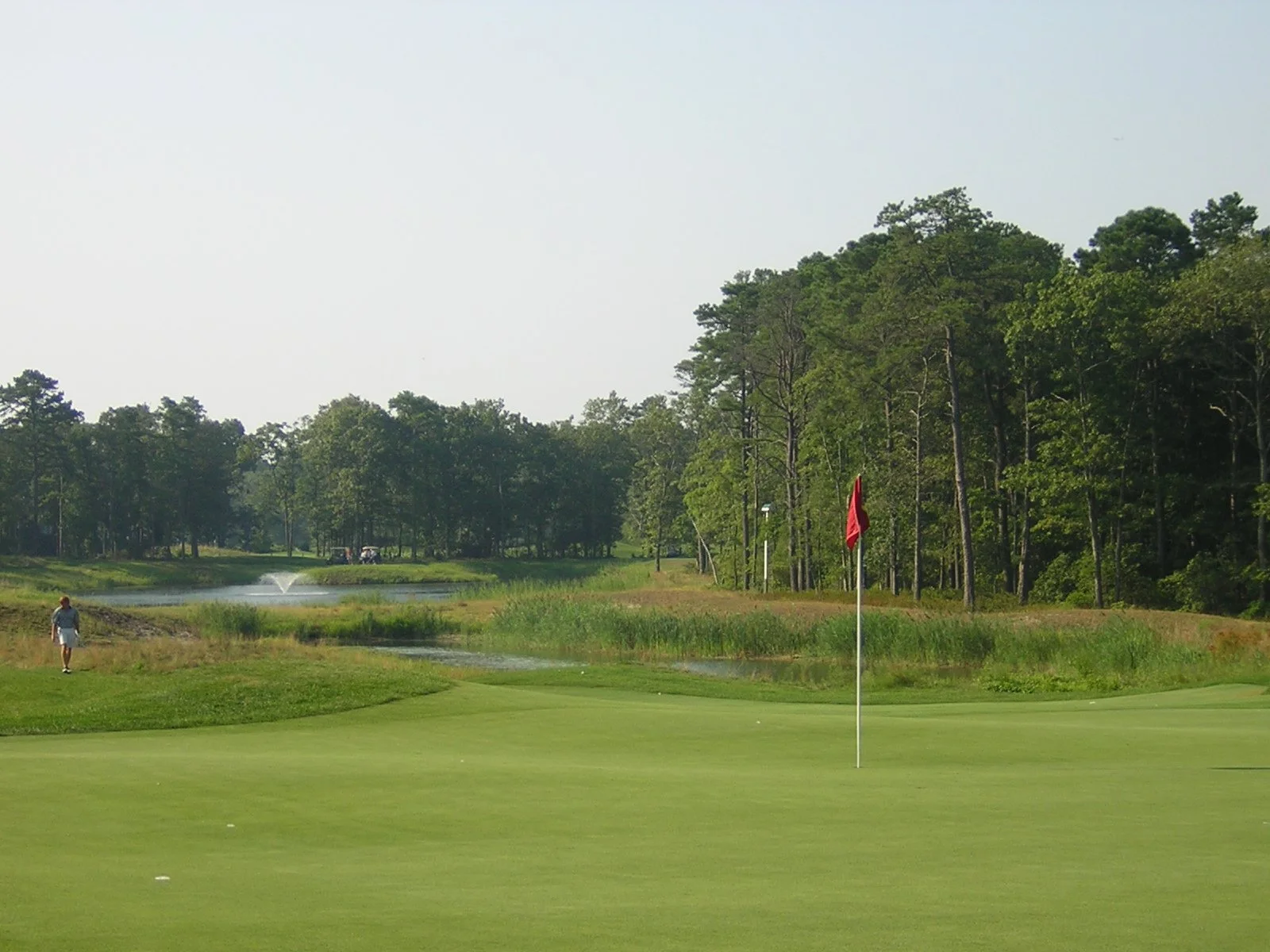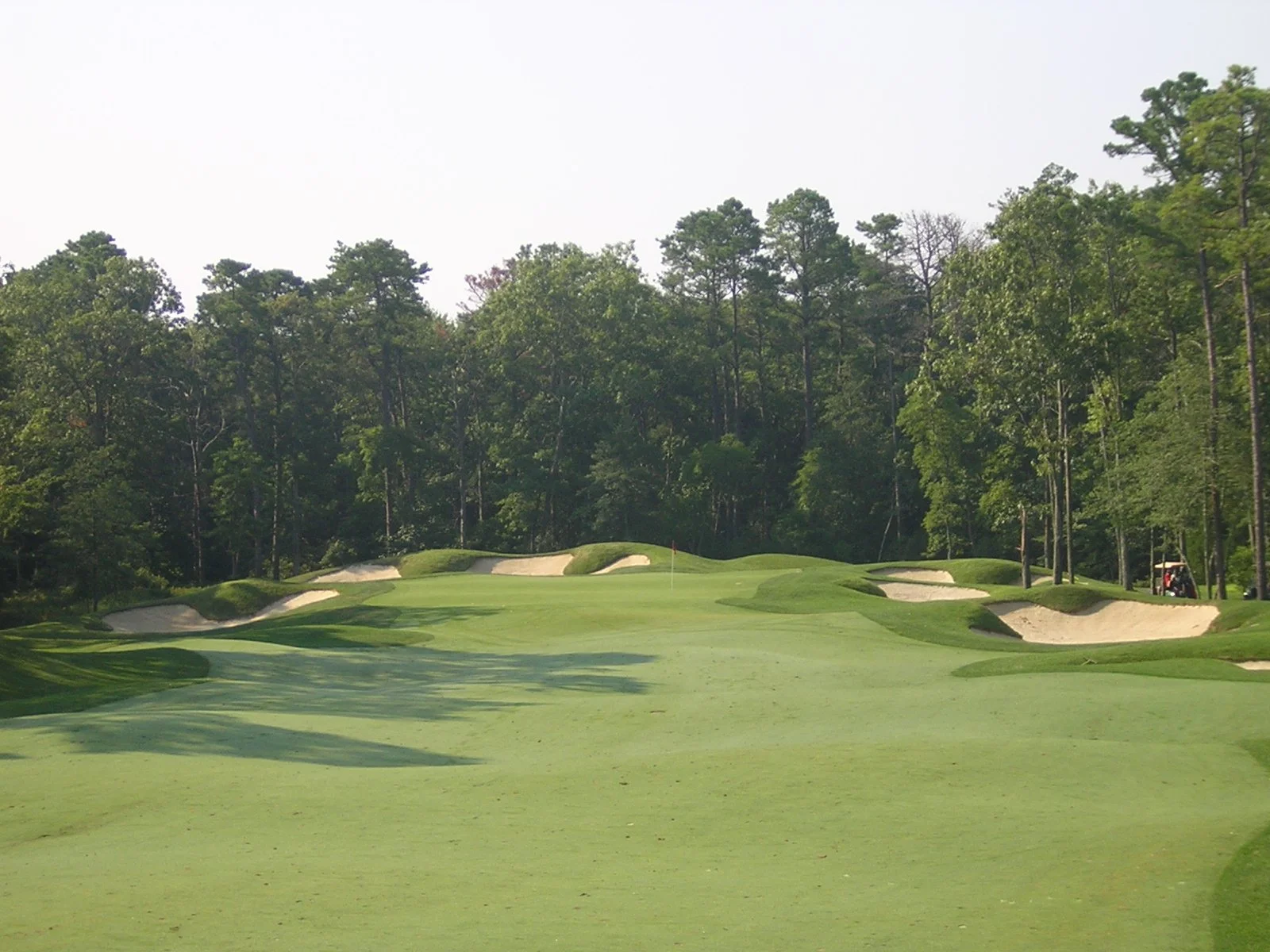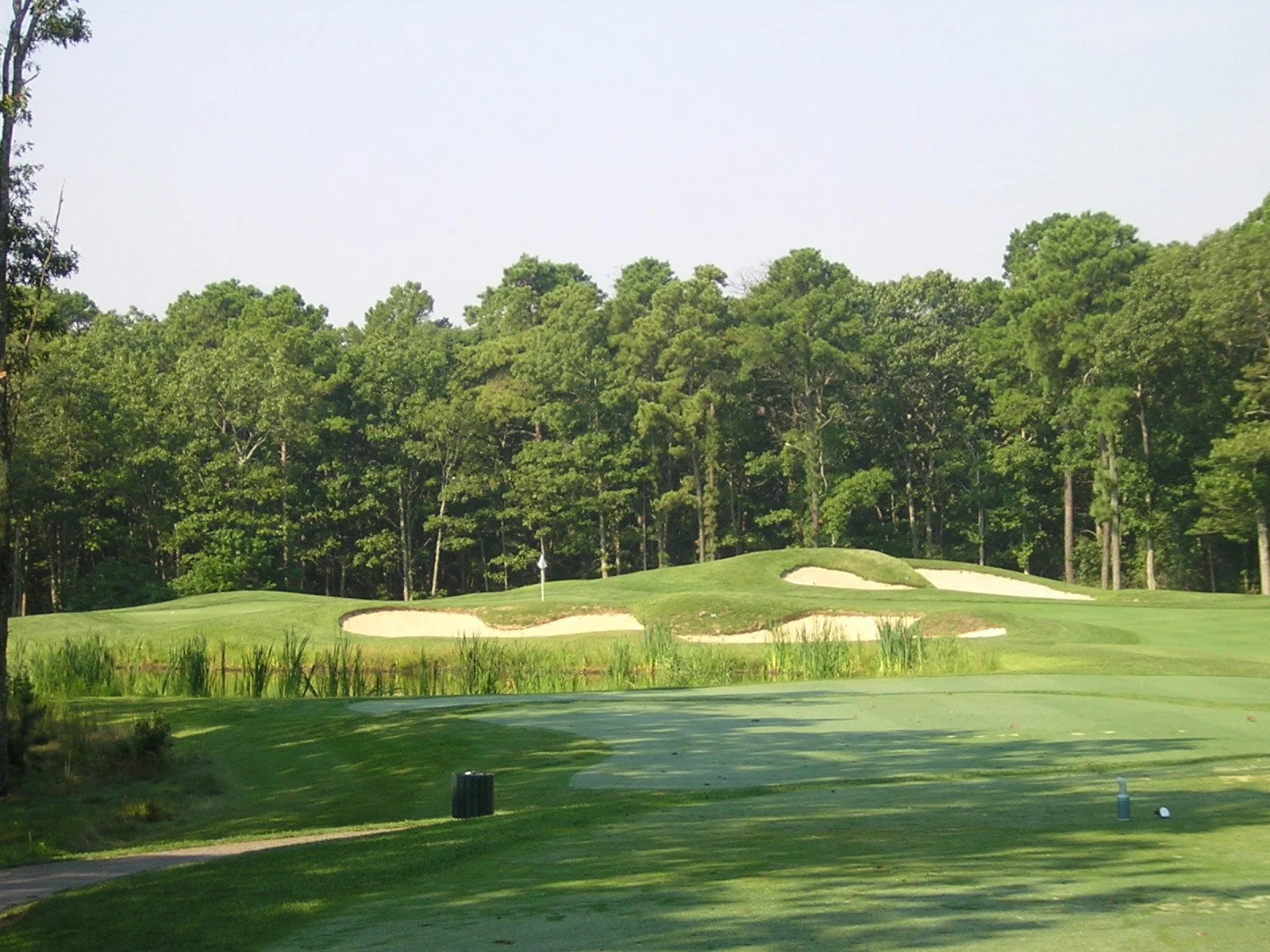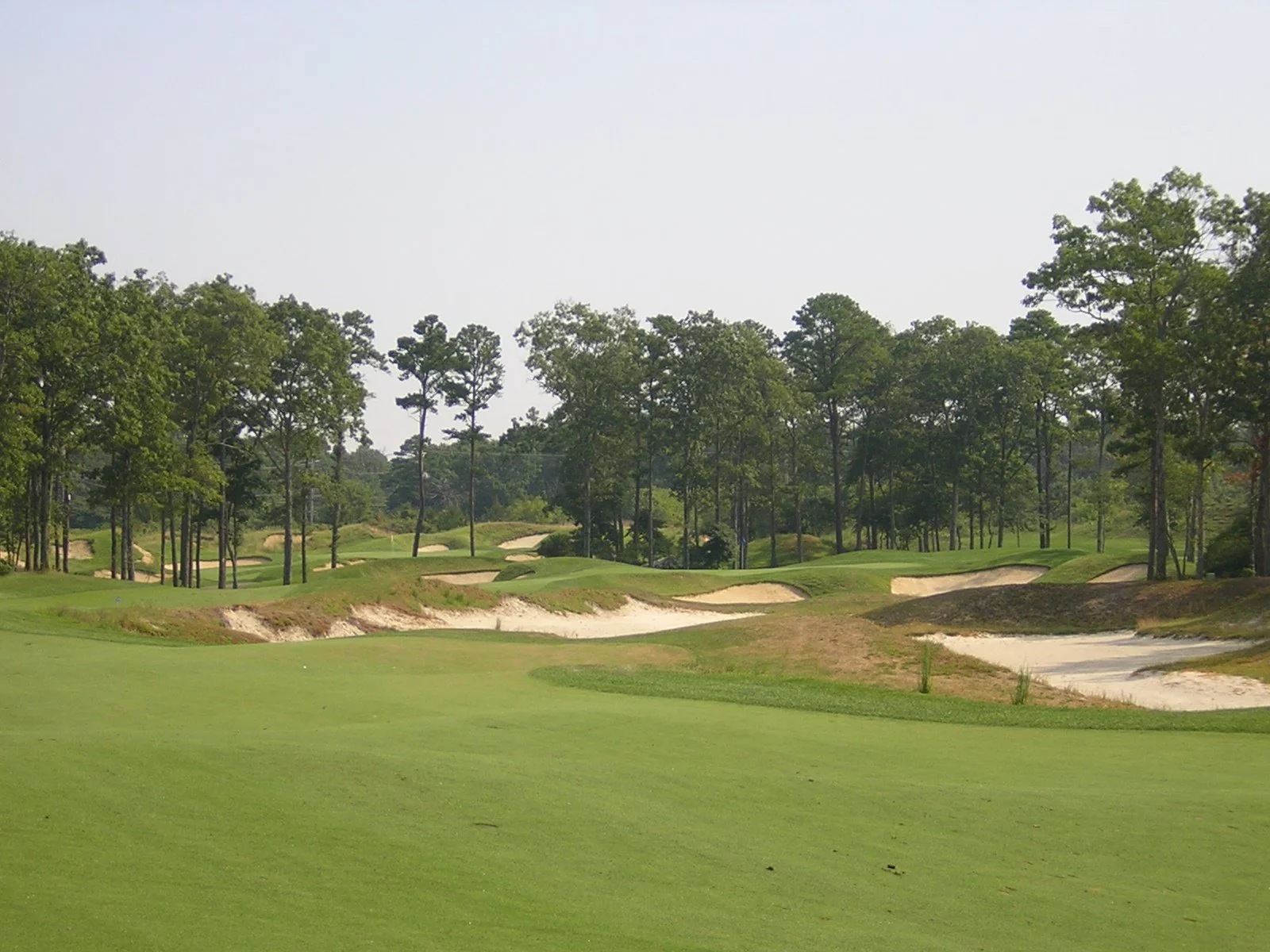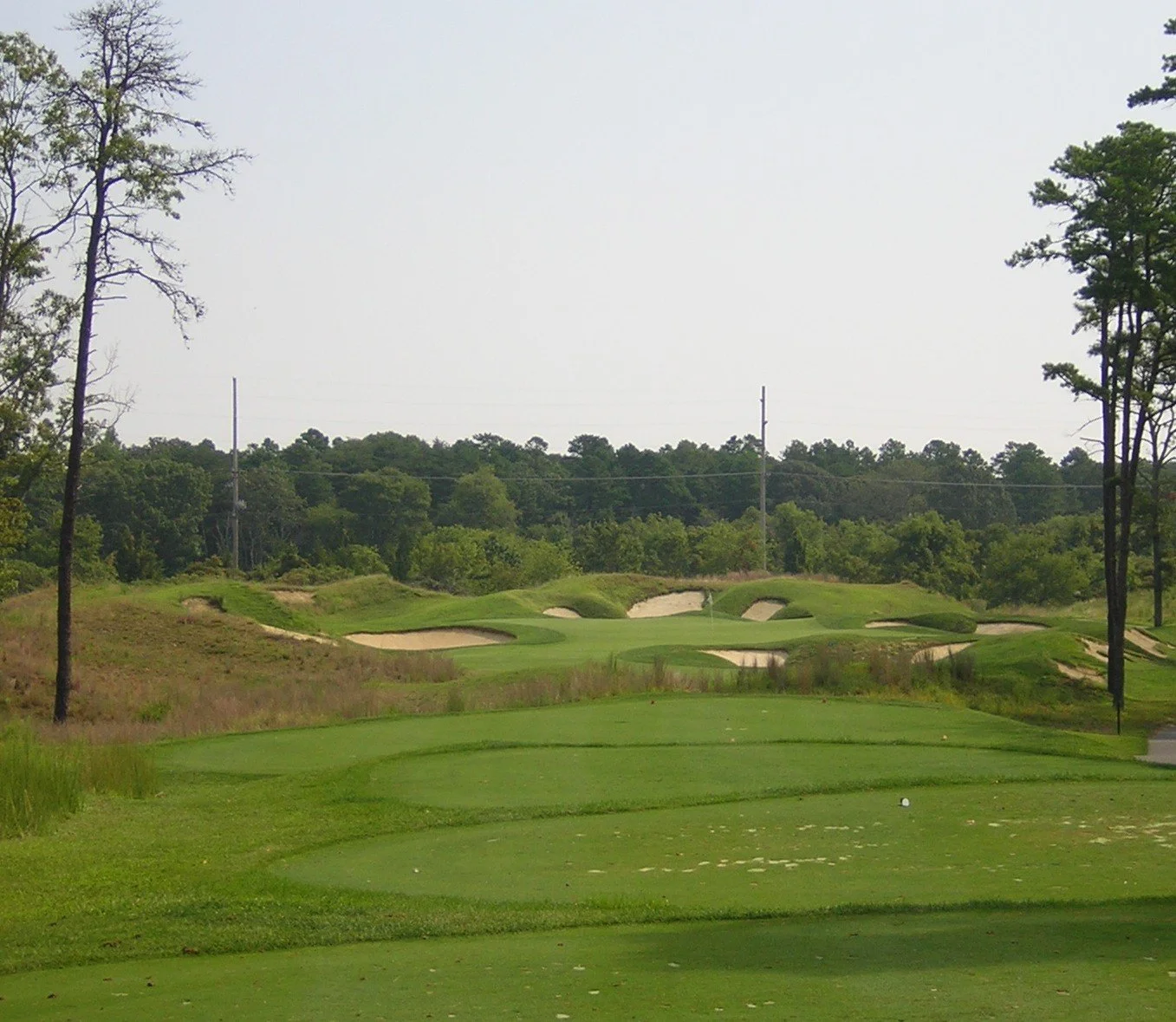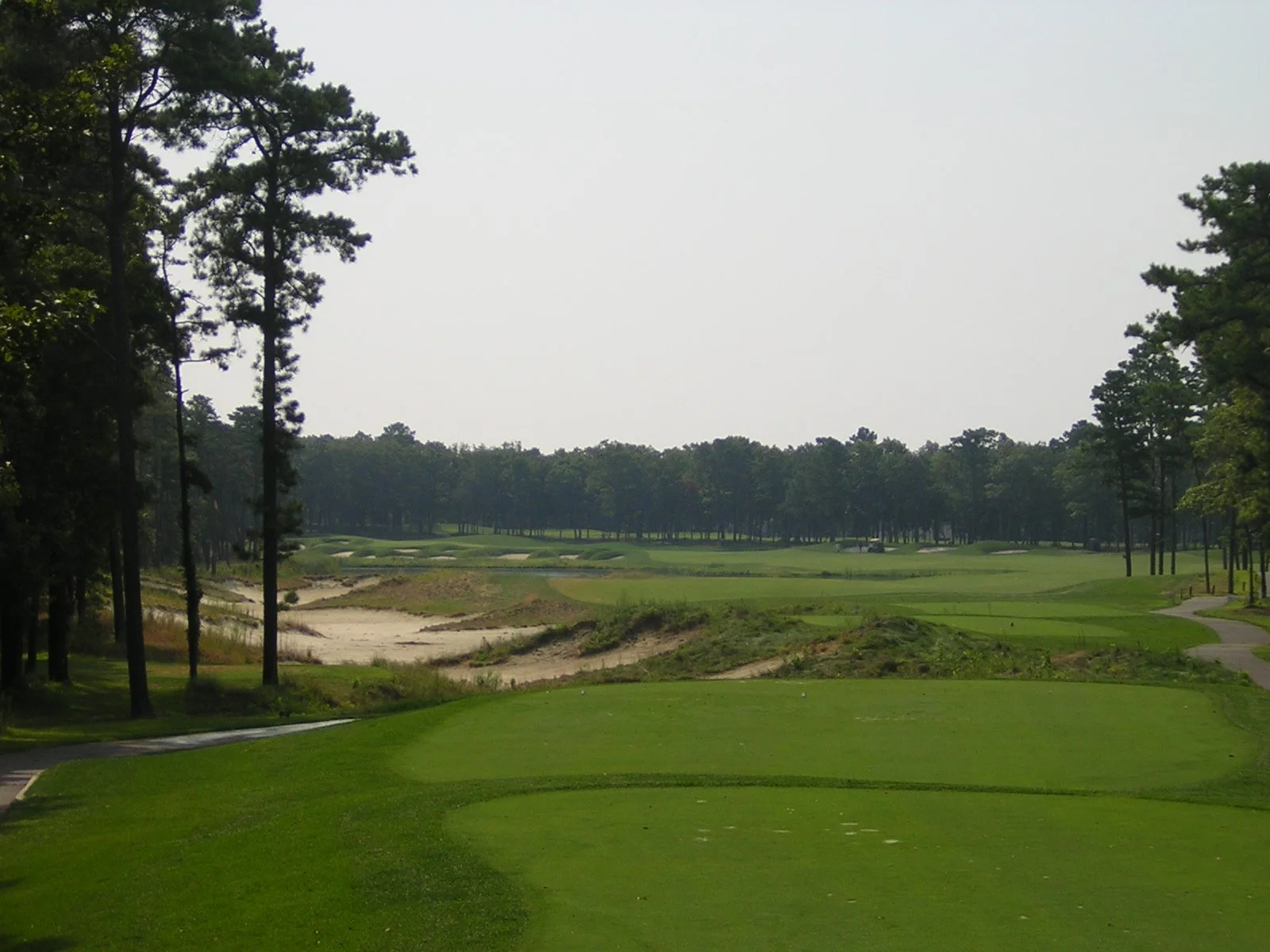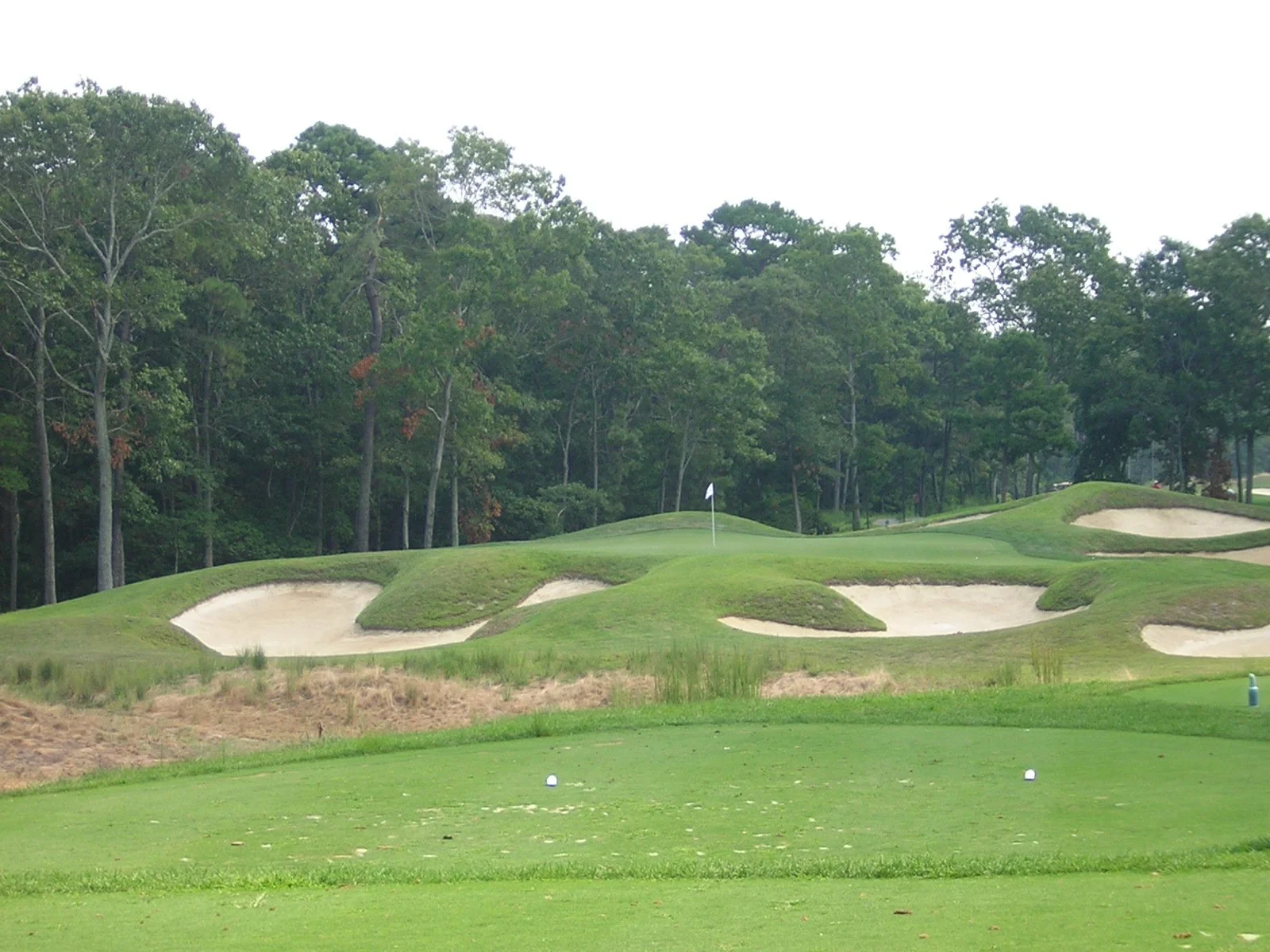SHORE GATE GOLF CLUB
Course Architects: Ron Fream & David Dale
Year Opened: 2002
Location: Ocean View, New Jersey
Slope: 150. Rating: 74.2
Par: 72
Yardage: 7,227
Hole-by-Hole: 1 - Par 4 394 Yds 10 - Par 4 470 Yds
2 - Par 4 432 Yds 11 - Par 4 409 Yds
3 - Par 4 404 Yds 12 - Par 4 410 Yds
4 - Par 4 370 Yds 13 - Par 5 556 Yds
5 - Par 3 163 Yds 14 - Par 3 144 Yds
6 - Par 5 589 Yds 15 - Par 4 406 Yds
7 - Par 4 401 Yds 16 - Par 5 542 Yds
8 - Par 3 225 Yds 17 - Par 3 204 Yds
9 - Par 5 648 Yds 18 - Par 4 460 Yds
Par 36 3,626 Yds Par 36 3,601 Yds
Awards Won: #2 Best Public Course in New Jersey - Golf Digest (2005-06),
#18 Best-in-State Rankings (NJ) - Golf Digest (2005),
4 1/2 stars - Places to Play - Golf Digest (2006),
Top 10 best new upscale public courses - Golf Digest (2004),
Top Ten You Can Play - Golf Magazine (2002).
Website: www.shoregategolfclub.com
HISTORY: You're handed 245 acres of pristine forest and told to carve a top-notch golf course out of the pine barrens of South Jersey, just minutes south of Atlantic City. That was the task given to architects Ron Fream and David Dale by Shore Gate owners, the Douglas Turner family.
Based primarily out of California, Fream and Dale have done most of their work in the Golden State and in the far east, such as Japan, Malaysia and South Korea. The Turners it seems, wanted to use someone that hadn't done a course in the area, as they were looking for something out of the ordinary. After meeting with Fream and listening to his ideas and thoughts, the job was his.
After traversing the site, Fream and Dale moved 450,000 cubic yards of sand and began to mold a dynamic course to challenge the best of players. Trees line most of the rolling fairways, sandy waste areas and water hazards are strategically placed, plenty of fescue and the bunkering, well, quite unique.
The architects placed 88 standard, so to speak, traps around the course, but added well over 70 sand-splashed, vertical dunes for a very interesting effect.
So what you have in the finished product is a thinking man's golf course. It features some forced carries, requires pinpoint accuracy, necessitates length and commands an all-around game. The bottom line, according to Fream, "This course does not cater to the 25 handicapper." Most feel, however, if approached from the right set of markers, Shore Gate is very playable for golfers of all levels.
In just a short period of time, Shore Gate has been recognized with the very best, receiving a number two rating for best public course in New Jersey by Golf Digest.
REVIEW: The most important function prior to teeing off at Shore Gate Golf Club is choosing the correct set of tees to play from. The course ranges from the red tees at 5,284 yards to the black buttons at 7,227 yards, so play with your head, not your cojones!
The opener at Shore Gate is a smart, dogleg left par four, just 394 yards from the tips. The tree-lined fairway should keep you honest, so three metal should be the play off the tee. Just a short iron should remain to a modestly undulating green with a pair of bunkers left and one right. A front flag, although closer, is tough to get at, so play middle of the green and two putt for par.
Numerous tee boxes highlight the second hole, on this rugged dogleg left par four. Water and waste areas guard the entire left side of the hole through the green. Don't be greedy. Play a draw over the center of the lake to set up your best opportunity to the green. The fairway is very receptive, but don't cut off too much or you'll end up in jail. The green is slightly elevated with a mammoth bunker short and right. The putting surface is flat in the middle, but the edges, especially left, fall off sharply. This is the longest par four on the front nine, so making par is a good score.
Sand dots the landscape on the dogleg left par four third. A drive of 239 yards is needed to clear the lake down the left side, however right is no bargain either with a dozen traps, most for sight, very much in play. Hitting the fairway with a three-metal does not guarantee an easy approach, as the landing area is very undulating and full of slope. Although just a short iron remains, club selection is key, as the putting surface is one of the longest on the course at 49 paces deep and multi-tiered. Four deep traps surround the green, making pinpoint control a must. Birdies yes, but par is OK.
The fourth is a straightaway, fairly short par four, requiring accuracy over length. Trees flank both sides of the fairway, so a three-metal is more than enough to reach the short grass. Another short iron is left to an elevated green that's wide, but very narrow. Club selection is key, for your approach, avoiding the deep, 70-yard bunker on the left and the trap right. Any shot long or left will result in a difficult up-and-down for par.
After four consecutive par fours, Shore Gate's first par three is a downright gem. Not very long at 163 yards from the tips, the key is choosing the right stick off the tee. A lake covers the left side through the green and two deep traps, one short and one deep wreak havoc for poor club choices. The putting surface is very undulating with a ridge in the center, running from front to back. A pin position in the left-corner can be a real round buster.
The first of two incredibly long par fives on the front nine, the sixth is a whopping 589 yards, a definite three-shotter. Your tee shot must favor the left side, as a very deep and 56-yard long bunker covers the right. Trees run down both sides of the fairway, but are very close to the right side. Three strategically placed fairway bunkers guard the landing area for your second shot. Once again, play down the left side of the fairway to set up the best approach to the green, thus avoiding the very deep bunker on the right. Just a wedge should remain to another long and tiered green, that runs hot from back to front and then up toward the fairway. A quartet of traps surround the green and at all costs, avoid the front bunker, as it's very deep and difficult to get any recovery shot close. Birdies are usually the norm on par five's, but not the third hardest hole on the course.
A boomerang of a par four, the seventh swings hard from left to right around acres of sand that runs from tee to green. Several diabolical, framing bunkers dot the landscape through the fairway, which narrows as you get closer to the promised land. Cut the corner if you must, but a three-metal to the 150-yard marker, will set up a short iron to a very slick green. One of the smaller putting surfaces at Shore Gate, the green runs from back to front and is very undulating. Any shot short and right will end up in the sand box, which sits well below the green. Play under the flag, putt uphill and be very content with a par.
One of the finest par threes at the Jersey shore, the eighth is the longest on the course at 225 yards. A fairway metal will be needed to reach this long and well-guarded green. Bunkers galore, 27 in fact, cover the entire hole from tee to green. Most are for aesthetics, but several certainly come into play, like the very deep front bunker or the difficult pot bunker left. The putting surface slopes from back to front and is multi-tiered, so club selection, especially when the wind is up, is critical. A par here is like stealing one from the competition.
That brings us to the ninth, without a doubt, the longest and most difficult hole on the course and in south Jersey -- 648 yards, yes that's right, 648 yards long from the back tees. Remember at the start, I mentioned to choose the right tees? Here is a perfect example. The drive alone must carry over 200 yards just to reach the fairway. A sandy waste area runs down the left side to the lake while tall trees guard the right. After a successful tee ball, the hole snakes around the lake to the left. A fairway club must be struck with precision just to cross the corner of the water, leaving a mid to short iron to the green. Three framing pot bunkers guard the landing area to the right, a perfect target to lay up. The putting surface is 47 paces long and narrow with three distinct sections. Any shot well left is wet and just missing left will be engulfed in sand. Bail right and rely on your short game to save par.
The inward nine opens with one of the most difficult holes on the course, a rugged 470-yard par four, that bends slightly to the left. Playing uphill from the tee, trees line both sides of the fairway, with bunkers guarding the landing area. A blast of over 240 yards is needed just to carry the trio of bunkers on the right side, the favorable spot to be as you approach your next play. Two deep traps cover the left side of the fairway that must be avoided to have any shot at reaching the green. A long iron or fairway metal will remain to a back-to-front sloping green. Bunkers on both sides of the green will keep you honest. Can you imagine a back-left pin? That would make par
almost impossible.
The 11th is a chance to get one back, as it's only 409 yards long. A large waste area runs down the left side of the generous fairway, while trees dot the right. The landing area does narrow the farther down you go, so three metal off the tee might be the play. As the hole bends to the left, just a short iron should remain to a medium sized green that's fronted by deep rough. Any shot long and right will make for a tough recovery, where sand and a severe slope await.
A rare straightaway hole, the 12th requires precision off the tee, as deep rough and tall trees guard the right. One of the few holes without fairway sand, this par four features a left-to-right sloping fairway. Beware, however, as any tee shot missing left runs the risk of clearing mounds and finishing in an environmental area. Now the fun begins, as a lake runs from 100 yards out and around the green to the right. Two deep-faced traps stand left and another right that's well below the green. The putting surface slopes hard from back to front with a ridge near the front and a chipping area in the rear. A back-right pin, tucked behind the sand and near the water could be very difficult, especially when the wind is in your face.
After a short cart ride through the woods, the long par five 13th comes in full view. Mounding and a half dozen or so unique sand-splashed wall bunkers run the left side of the landing area, while a beach-type waste area runs the right. It's certainly possible to get home in two, but the chances are slim and none, as the fairway is just a few paces wide the closer you get to the green. Your second shot layup must be placed precisely between numerous fairway bunkers on both sides of the right-to-left sloping fairway. From there, you should be able to attack the two-tiered putting surface, especially with a front flag. A word of caution, miss right of the green and it's a sandy waste area, while left are a pair of very deep bunkers well below the green. Although ranked as the second-most difficult hole on the course, the 13th can be had.
Speaking of making birdies, the 14th is the easiest and shortest hole on the course, just 144 yards in length. A short iron can attack the elevated green, but deep sand traps lurk around the entire green, not to mention a sharp drop off to the left of the putting surface. The green is also the smallest on the course, just 23 steps in length with a large tier in the center that runs from front to back. Take dead aim with your short iron. A "2" always looks good on the scorecard.
Not long in length at 406 yards, the 15th is one of my favorites on the course. A beautiful, dogleg right over water and waste area, this par four requires a properly placed tee ball down the right-center of the fairway. The undulating landing area narrows at 140 yards, so three-metal off the tee might be the play for the longer hitter. Deep bunkers and mounding are down the left side, so stay clear, or you'll be chipping out to the fairway. Your second will be with a medium iron across a lake to a very long green with several tiers. Pin placement will dictate club selection, where you might be forced to hit as much as a long-iron. Any shot short or right will be wet and bailing out left is no bargain either, as a deep bunker will capture any errant shot. Last time out, I needed a 4-iron to get home, two-putted for par and was all smiles.
The tee shot on the reachable, par five 16th is the most critical play on the hole, as it must carry well over 200 yards over a lake to the fairway. Not an easy task with the wind in your face. Down the right side is the best play, however, it's also the longest part of the lake to carry, 236 yards from the tips. Trees flank both sides of the bunkerless fairway, so anything off the mark will result in a pitch-out, trust me. If successful off the tee, a fairway metal should remain to the promised land, however, a tall tree stands some 60 yards short of the green, swatting down any shot not high enough to carry. The best play would be down the right side of the fairway, past the tree for the best approach to the left-positioned green. The putting surface slopes hard from back to front with a horseshoe shaped bunker, front right that sits well below the green. Any shot below the hole, could spin off the green, so your wedge approach needs to be spot on for your birdie attempt.
The 17th is a well-conceived, long par three of 204 yards -- visually intimidating off the tee, with a large waste bunker fronting the tee and a deep bunker, short right-center of the green. A long iron or hybrid is needed if your playing the tips to reach one of the longest and widest greens on the course. Several tiers and slopes can play havoc, even with the best of putters. Two bunkers guard the left side with one enormous trap deep. A tough hole to make par, especially with the match on the line.
The closing hole is another doozy. Bending slightly to the right, the 18th forces you to hit a power-fade, as trees line the right side of the tee box. The fairway is open to the left, but requires a 230-yard play to clear the waste area. A medium to long iron remains to another monster, slightly elevated green, 47 yards long with multiple tiers. Deep bunkers guard both sides of the putting surface, so your approach must be struck with authority. What a finish!
OVERALL: With all of the new upscale public courses in the south Jersey area, Shore Gate Golf Club is only course of the bunch with a 4 1/2 star rating by Golf Digest. That's high praise for a course that's been open for less than a decade. "It's a wonderful acknowledgement of the quality of the golf course and of the commitment all of us here share to ensure the best possible
experience for our members and guests," commented former head golf professional Harry Bittner.
Shore Gate is not for the faint of heart, even from the lesser tees, as evidenced of the slope rating of 126 from the red markers. One reason is the difficult fescue rough. Despite being trimmed down the past few seasons, it's very tough to escape from. The bunkers are very deep and varied, making sand saves arduous at best. Tree-lined fairways require accurate tee balls and the length of the course necessitates strength. As mentioned at the beginning, if you choose the right tees, you'll have a fighting chance, otherwise, you're in for a long afternoon.
The course, with rolling fairways, undulating greens and a wide variety of holes, is very unique to the area, which features mainly flat, somewhat uninspired layouts. "Shore Gate is a copy of no one and nothing else," commented Fream. The course is made up of bent grass tees, fairways and greens and blue grass rough and fescue. A total of 88 standard bunkers dot the premises, not to mention numerous wall-styled traps. Don't forget the seven ponds and lakes.
Let's talk about the amenities. The clubhouse is probably the weakest part of the property, but it has what you need. A fully stocked pro shop and a place to stretch your legs with a cold one after your round. Missing is a full locker room equipped with showers, etc.
The practice facility is solid, the staff is extremely courteous, especially the starter who gives you the lowdown on the course and which tees to play, even though he doesn't know your game. The course can be walked, but it's a long track, so take the cart that comes with your fee. Speaking of which, the price during the season is reasonable for a high-end public course, around $100, and during the offseason, the price can be as low as $50 in October for a twilight time.
The bottom line, Shore Gate Golf Club is the most difficult public course in south Jersey and for the golfer who wants to be challenged, this is it. You will use every club in your bag and try shots that you have never done in the past. That's what I call a golf course. Forget the rest, Shore Gate is the A.C.'s best.


